👥 250,000 Trained
🏆 9 x Award Winners
⭐ 96% Review Rating
📈 24 Years of Proven Results
Written by Sean McPheat | 
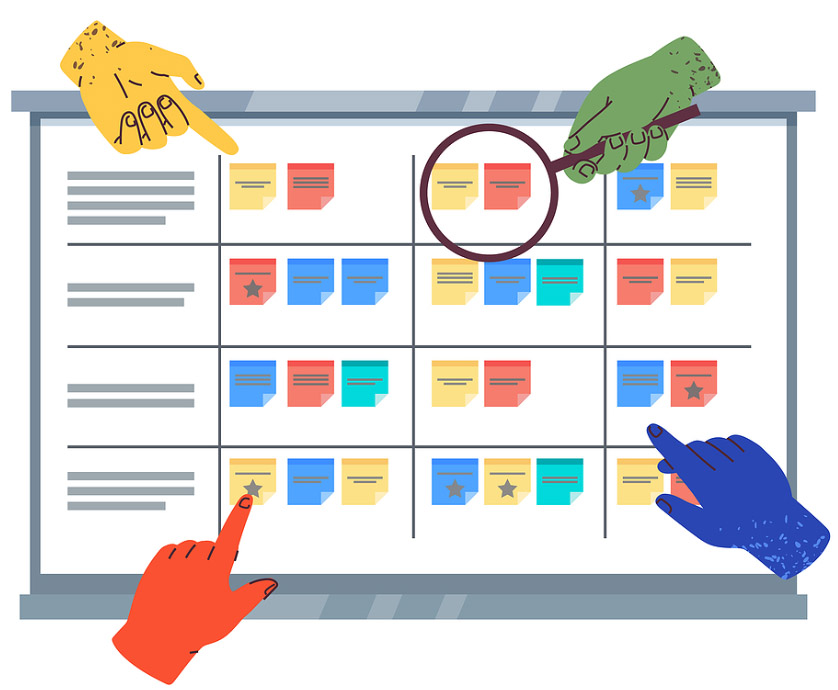
Most salespeople do not know what a Sales Battlecard is. But those that do know and use them, tell us that they are a vital tool to help them sell more effectively.
Did you ever use flashcards when studying? You’ll remember they contained short, concise answers to the most important information that you needed. Well, Sales Battlecards are similar!
No matter if you’ve never heard of them, or you want to start to use them more effectively as part of your Sales Training and development, this essential guide to Sales Battlecards will provide you with all you need to know and get you battle ready for any sales pitch.
Contents

The last thing you want is for you or a member of your team to become flustered during a sales call or meeting! If a prospect fires a sudden, urgent question over, you want the answer ready at your fingertips. This is where Sales Battlecards come in…
In as few words as possible, either on paper or onscreen, Battlecards help to summarise all the key points of a sales pitch. They should usually include:
Different Battlecards contain different categories of information. A B2B product may require more of a corporate focus, stressing the product’s benefits for a department, or the efficiency gains the product offers. Whereas some Battlecards will include guidance on when to engage, or disengage from a sales conversation, which may help less experienced sales reps make good use of their time.
In competitive sectors, many Battlecards devote a lot of space to the claims of rival brands and how these can be addressed or refuted. This is useful when consumer objections tend to hinge on your competitors’ offerings.
The stress given to each of these elements (product, process, competition) and other factors, will depend on the nature of the sector, the type of pitch, and the product.
In summary, Battlecards make a great resource to include in your sales strategy and for you and your teams to utilise during a pitch to improve results.
There are many different situations in which your Battlecards may prove helpful.
Let’s go over a few.
Both before and during a sales pitch, it helps to have a Battlecard ready. This is to ensure that the pitch stays on track, and you can accurately address any questions your listener may have. Even if you don’t refer to the card during your pitch, it can help your confidence knowing that the information is ready at hand should you need it.
A word of caution however, you may not want to let your potential customers see your Battlecards. Particularly if they contain competitor price comparisons or other information you want to know, but not to share!
Regularly revising your Battlecards can help you address competitor moves and maintain a competitive edge.
For instance, your main rival may launch a new edition of a software product while your next edition is still in the pipeline. Your Battlecards may need to be revised to stress how your existing product still offers superior value for money, while potentially teasing the new edition, which subscribers will be able to upgrade to when it is released. Helping you to deal with competition confidently.
With complex products, it can be difficult to remember all the features and specifications. A well constructed Battlecard can bullet point all the main features, so that you can memorise them, or at least have them to hand should you have a memory lapse.
If you find there are common sales objections to your value proposition, or to your price points, then it can be helpful to have compelling responses prepared to address these issues. In times of economic hardship, or in a highly competitive sector, overcoming hesitancy could form a significant part of your pitch, so having all the answers at hand could make all the difference.
When you’re going into a pitch and specific conditions are known beforehand, then a Battlecard can be tailored to deliver relevant information.
For instance, let’s imagine you’re going into a meeting where you’re aware that your buyer currently uses a competitor’s product. Your Battlecard should contain a comparison between the features and benefits of your product and the rival product. Obviously this will stress favourable comparison points, but it will also contain responses to objections, where a comparison may appear unfavourable.
These are useful where there are several popular products, of which your product is just one. You’ll want a comparison chart which shows your features and benefits alongside your rivals.
Again, you may want to avoid sharing this type of battlecard with a client, so it may prove more valuable when selling over the telephone or when emailing contacts. It’s unlikely that your product will beat the competition in every single category, so your battlecard may include responses to buyer objections, for more unfavourable comparisons.
As you can see, Battlecards are all about arming yourself and your sales team for battle! They are a type of ready reckoner which enables your sales team to:
So long as your Battlecards are set out logically, it may be preferable, for complex products or sales situations, to have a set of Battlecards, each fulfilling a different function. For instance, you may have one for specs, features, and benefits, and a second one focusing on competitors and objections. Many physical Battlecards are two sided, for this reason.
If you adopt this approach, make sure it’s obvious what information will be found on what card, to avoid awkward silences and fumbling.
There’s a real art to writing a good Sales Battlecard.
The first thing you’ll notice when researching Battlecards is that there are a huge variety of different layouts and approaches to the topic. There really is no single universal template for a Battlecard.
There are very good reasons for this… every sector is unique and different products require different approaches. However, as we’ve already seen, there are some elements that Battlecards nearly always include.
This means there is at least one unified approach you can take to obtaining all the information you need. Here’s the data you need:
By now you’ll probably have gathered a bewildering amount of information, data, and ideas. So here’s the challenging bit – boiling it all down to just the essentials!
A good tip is to use a highlighter pen, or cut and paste snippets onto a new document, so that you’re only including the most valuable information.
Once you’ve done this, you’ll still probably have too much information, and certainly it will be long winded in terms of how it’s written. So, you guessed it, now you’ll have to finalise your content and begin to bullet point it – remember it’s key to use as few words as possible!
Now arrange the key points/bullets into categories – facts about the product, about target markets, about competitors, etc. Format the information so that it’s consistent and creates a structure and that it’s easy to find the information at speed.
Lastly, make sure you test your Battlecards with some roleplayed sales encounters and adjust the layout and content accordingly. You could also hold focus groups with a sample of your salesforce, to find out the best way to shape your Battlecards.Once you’re confident that they are performing well, you can try the cards out on a few actual customers, before making final tweaks and rolling them out across your whole team.
The last point is key. Battlecards can never be a “once and done” solution. When a product changes, or prices increase, or a new competitor enters the field, or a thousand potential other changes occur, you’ll need to revise your cards.
Don’t rely on individual reps to amend their own cards. Instead, adjust and reissue them. However, once they have been revised, make sure everyone is working from the updated card.
Having explored the flow of shaping a Battlecard and its contents, let’s now have a look at a few examples so you can grasp some of the types and designs that are out there.
Here’s a Battlecard for corporate health insurance plan:
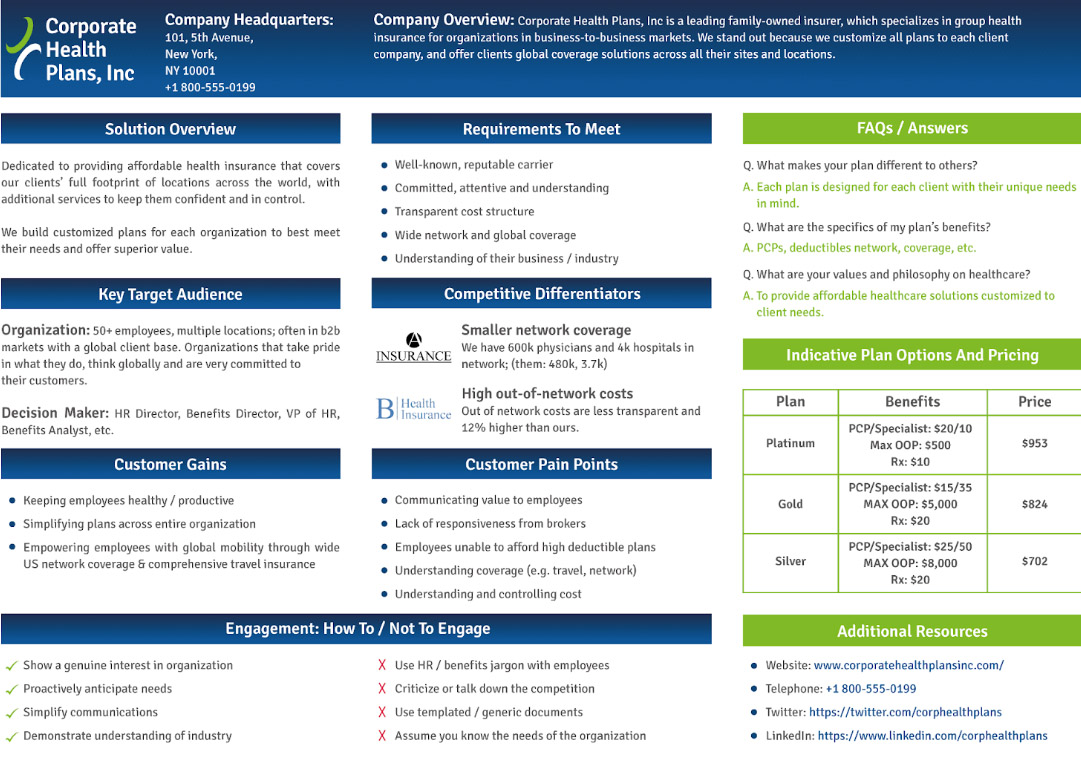
[image courtesy of b2binternational.com]
In this example, “solution overview” gives a concise description of the product while “requirements to meet” and “key target audience” help the sales professional identify who they should be talking to. There’s also a brief section on key competitors and a summary of customer benefits and pain points.
To aid the rep with lead qualification, there’s also a section outlining the conditions for continuing with a sale or abandoning it. Finally, on the right-hand side, there’s a differently colour coded section for FAQs, key figures, and other resources.
This Battlecard is well laid out and uses as few words as possible within each bullet point. There’s lots of white space to help the reader locate the information they need.
Here’s an example of a competitive Battlecard, courtesy of LinkedIn:
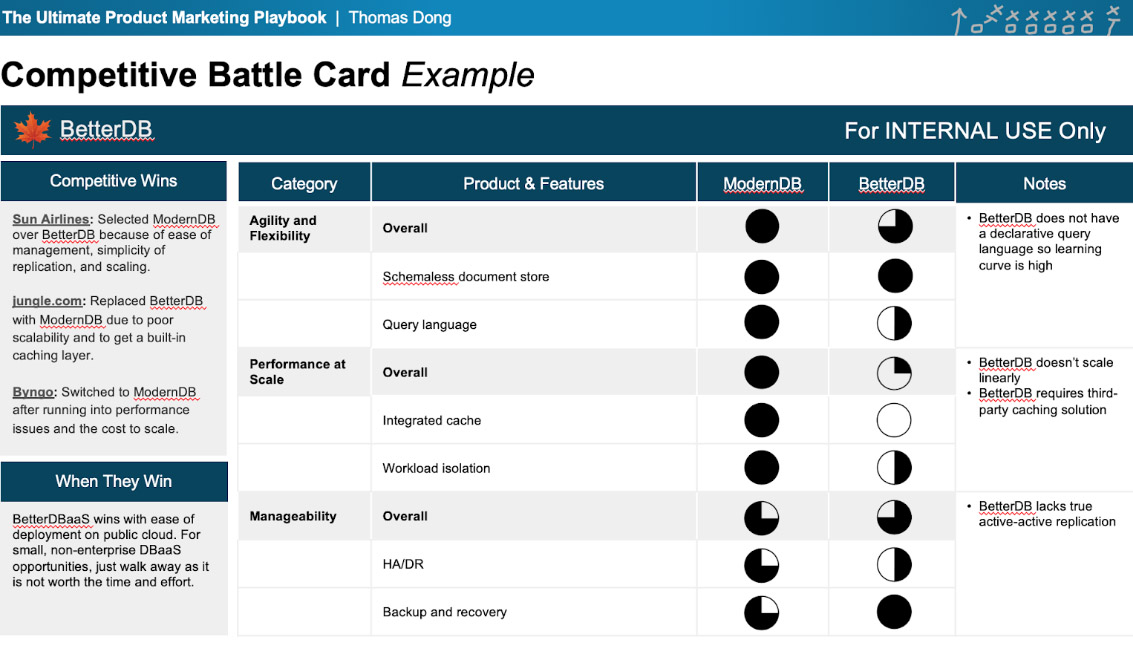
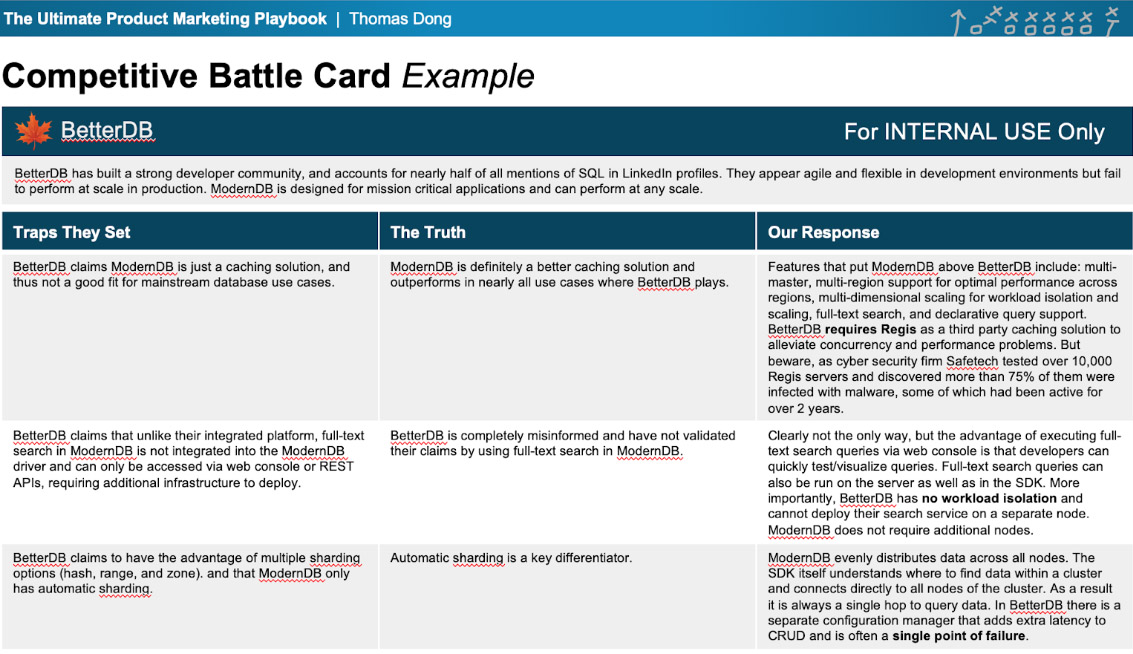
[images courtesy of LinkedIn]
The first thing to notice here is the important warning on the top right of this Battlecard: “for INTERNAL USE only”. This is an example of a card you do not want to share with your buyers!
This Battlecard belongs to a SaaS provider called ModernDB, and compares their product with their chief rival, BetterDB. Side one addresses some of the sales messaging their rival has put out and offers responses to each argument. Side two gives a handily graphic presentation of key features and how ModernDB compares with its rival for each consideration.
Note that under “Manageability”, the graphic icons indicate no overwhelming benefit to the product, and under “backup and recovery” the rival product scores better. However, this has been addressed in the “notes” column, giving the edge back to the sales rep’s product.
This level of honesty in the data presented, allows the rep to properly address potential buyer concerns. However, it also explains why you wouldn’t want to share this card with your potential customers.
Finally, let’s look at a different kind of competitive Battlecard template, laid out in a more specific manner:
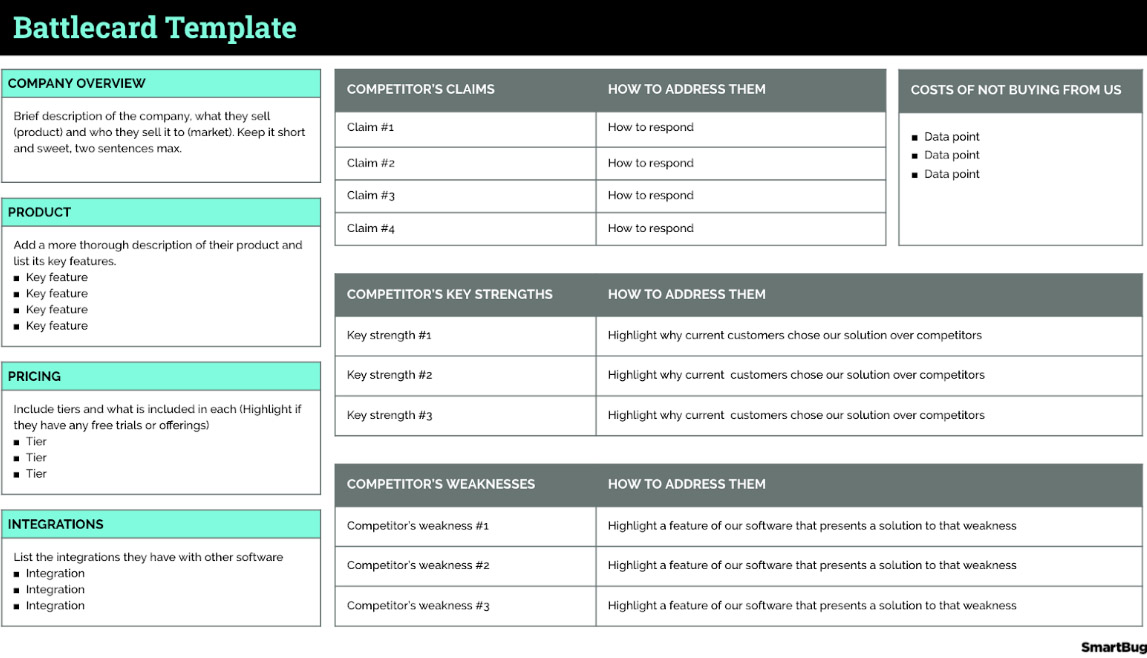
[image courtesy of Smartbug]
This template benefits from being very clearly laid out. It digs deep into competitor claims, strengths, and weaknesses, offering an answer to every factor which could come up in a sales meeting.
In the top right of this card there is a space for some positive facts and figures, although it could be more positively framed (“benefits of buying from us”).
The section on ‘integrations’ is specific to SaaS products and could be replaced with something more relevant to physical products (such as finance plans, optional extras, or insurance packages).
Hopefully these examples give you an idea of both the value and the variety of Battlecards and that you can adapt it to suit you. There is no one format that works for every company; only you will know what’s most important to your industry, product, and marketplace. However, try and stick to the following essential qualities if and where you can:
Have a logical flow and be easily navigated
Battlecards are powerful tools. Whilst they may not be useful during face to face sales meetings, they can prove invaluable for telephone or virtual meetings.
Of course, a Battlecard is only as good as the accuracy of its information, so it’s vital to keep them up to date as prices change, new products are developed and new competitors enter the field.
Hopefully, making them a regular resource will help you and your team maintain consistency and really shine.
If you are looking for more sales support for your teams, please contact us to discuss any Selling Skills Training.
Or take a look at our full portfolio of Sales Training Courses.
Happy Selling!
Sean

Sean McPheat
Managing Director
MTD Sales Training
Updated on: 4 April, 2023
Related Articles

Search For More
